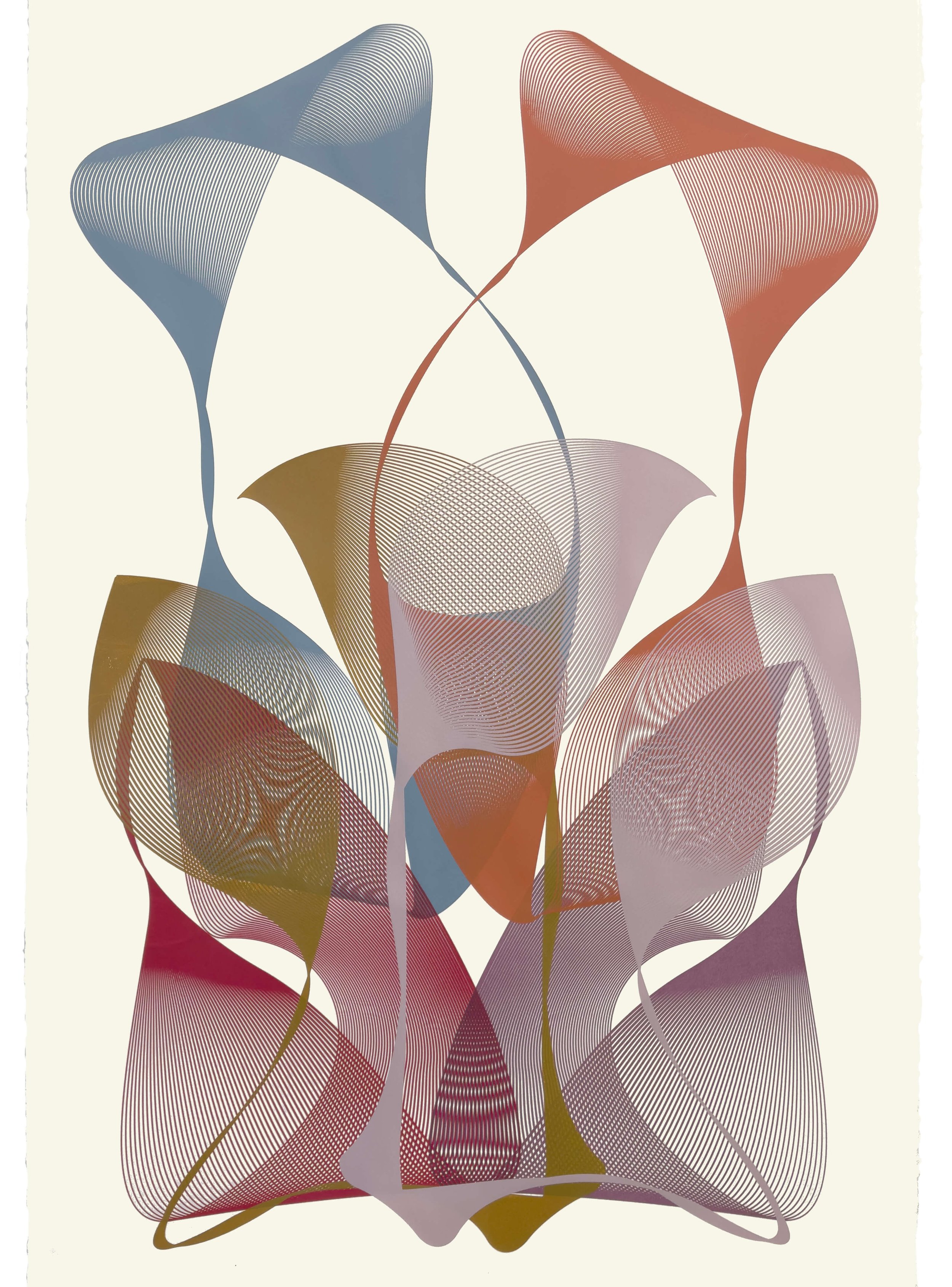Kate Banazi: A Multi-Media Artist’s Journey Embracing the Glitch
By Christina Nafziger
Crisp, clean, mesmerizing, and fluid. These are the words that come to mind when I look at the work of multi-media artist Kate Banazi. Her style is undeniably rooted in geometry, yet there is an organic nature to much of her work. A strong balance is present, often with complex, overlapping lines and patterns that give the impression of motion. Working primarily in printmaking and sculpture, Banazi utilizes both two- and three-dimensional forms to create her body of work, which includes silkscreen prints, wall sculptures, collages, and a permanent 30-meter sculpture in Sydney.
Join us in conversation as Banazi tells us about growing up in a creative home, embracing the glitches in the silkscreen process, and the deeply personal work in her solo show at Curatorial&Co titled BACK HIPS BONES LIPS.
You have many different talents and use various mediums. What was your journey like getting to where you are now in terms of materials, primarily working in printmaking and sculpture?
When I first moved to Australia, I had no access to printmaking facilities, so I had to cobble together a workspace on a balcony covered in a plastic tarp. Although frustrating, it was also incredibly freeing and pushed me to experiment with my approach. Pieces like my sculptures needed to be modular so they took up little space before fabrication, but I was also keen to create the layering of silkscreen prints in a more three-dimensional form. The progression really happened when I started to dig deeper into the stories I wanted to tell through my work, as well as the people I’ve been able to collaborate with. These champions of creativity have been intrinsic in pushing my work further.
Can you tell us about growing up in a creative home? Were your parents artists as well? How has your background and training in fashion and menswear influenced your current practice?
My parents were graphic designers and typographers and remain busy with projects. They both came from creative families, with roles like sign writers, cabinet makers, and perfume makers. There was always an understanding at home that if we gravitated toward a creative profession, it was accepted.
I loved the research and construction of fashion. At that time, it was still slow and seasonal, so there was time to build narratives and be involved in multiple processes. I remember working for a tailor who would freehand draw directly onto fabric for a suit. It was incredible to watch that skill, intuition, and confidence come together. I continue that in my art practice by collaborating with others and being curious about their processes. These relationships often challenge me to think differently about my work. There's a clear influence of body and pattern cutting in my work, with layers that echo clothing construction over the body—concealing or revealing elements, often hinting at muscle mass or sinew. The substrates I choose are always complementary to the artwork and its narrative.
Looking at the breadth of your work, your two-dimensional and more sculptural three-dimensional pieces appear connected aesthetically through form, shape, and geometry. Can you talk a bit about this? Do you feel there's a through line connecting your body of work?
There's definitely a thread running through most of my work: line, color, and an abstract geometric foundation. All my work starts with line drawings or brushwork, whether it’s of the human body, landscape, or objects. The idea is that by filtering the concept through multiple processes to reach the final outcome, it mirrors how we view each other—filtered through screens and curated information, with a chance of a genuine connection. It's a somewhat glitchy but beautiful half-truth. I'm now experimenting with a more ornate layering, which I'm enjoying, embracing glitches in the silkscreen process, and focusing on spontaneity. Part of this challenges me to let things be, reflecting on myself, my body, and my place in the world. Color is crucial to me—it evokes different responses, whether attractive or challenging.
Whether through creating or the internal struggles of being a working artist, art can be personal and emotional. How do you deal with the emotional effects of your art practice? How do you decompress?
I don’t take enough time to decompress and often burn out to the point where I need a few days of bed rest—bad habits! But I do have dogs, so getting out with them helps me find balance. We have a small garden, and sitting outside, seeing the seasonal rewards of nurturing green space, brings joy. But I thrive when I'm drawing or making things; I can't deny that. Post-solo show, I've been sitting outside, drawing, reading, and listening to music. Recently, I've been dealing with vestibular migraines for the first time, so my body is clearly telling me to reassess how I work and rest.
What are you currently working on? Do you have anything coming up that you'd like to share?
I currently have a solo show in Sydney with Curatorial&Co titled BACK HIPS BONES LIPS. It’s a deeply personal exhibition, with motifs drawn from my own physicality as I attempt to visualize holding onto memories and words while my body feels like it’s in chaos.
Where can people see your work in person?
The best place is my gallery, Curatorial&Co, in Sydney, Australia, at 80 William Street, Woolloomooloo, or on my website at www.katebanazi.com.
What is the art scene like in Sydney, where you're based?
It’s a vibrant landscape filled with diverse and interesting visions and voices. Support for the arts has been stretched over the past few years, but it’s been fantastic to see how many curators and artists have fully embraced creating new opportunities and spaces for emerging creatives across all genres. Many of my friends work in creative industries, so I’m constantly surrounded by a wealth of talent and ingenuity.








